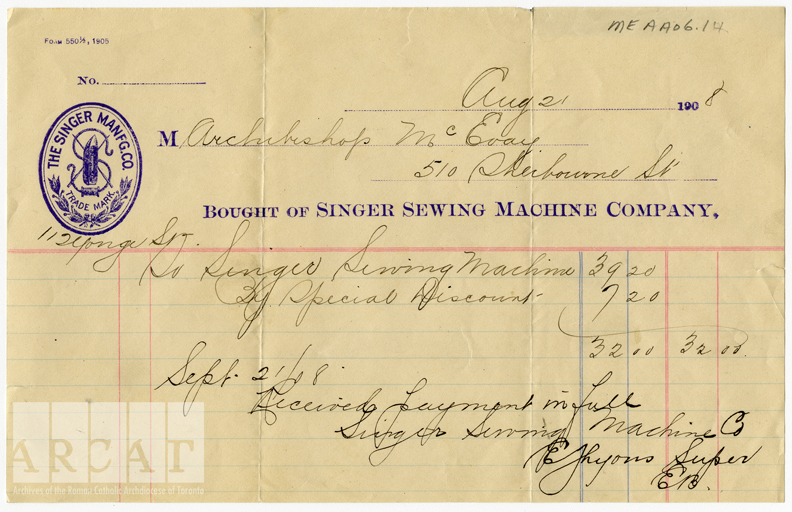We are blessed to have living and serving among us more than 900 religious men and women of 100 different religious congregations. Although we could not feature them all, you can still honour these orders by observing the World Day of Prayer for Consecrated Life on Sunday, January 31 at 3 p.m. at St. Paul's Basilica (83 Power St., Toronto). This will be a special Mass to close the Year for Consecrated Life.
___________________________
This week, we highlight three missionary orders: The Missionary Oblates of Mary Immaculate, Scarborough Foreign Mission Fathers, and Our Lady's Missionaries.
The Polish Oblate Fathers (O.M.I)
Last week, the Missionary Oblates of Mary Immaculate celebrated the 200th anniversary of their order's foundation by the French aristocrat priest Eugene de Mazenod. The Oblates' first aim was to serve the impoverished parishes of Provence, whose spiritual needs had been neglected following the French Revolution and Napoleon's anti-clerical governance.
In 1841, Canada became the first foreign mission of the Oblates with headquarters in Montreal. Towards the end of the nineteenth century, the order sent for more priests from Europe who would be able to speak the languages of new immigrants to Canada.
In 1935, the first Oblates of Mary Immaculate arrived in Toronto to administer St. Stanislaus Kostka Parish. These Polish priests were part of the Polish Oblate Province in Canada, called Assumption Province. Following World War II, thousands of Polish immigrants came to Canada and settled in Toronto. Under the Oblates' leadership, parishioners were able to place every family that arrived.
The Polish Oblate Fathers have continued to administer St. Stanislaus and well as St. Casimir's (Toronto), St. Maximilian Kolbe (Mississauga), and St. Eugene de Mazenod (Brampton). The Assumption Province Oblates also run the Queen of Apostles Renewal Centre in Mississauga.
Read more about the Oblates in Canada in this special section of The Catholic Register.
 |
| Photographs Collection, Religious Orders Series, PH27O/01P Group photo of the Oblate Generalate in Rome, 1949 with Cardinal McGuigan and Bishop Allen (front, 4th and 6th) |
Scarboro Foreign Mission Society
Rev. John Mary Fraser, the founder of Scarboro Missions, was a Toronto-born priest ordained in Italy to serve as a missionary. In 1902, he became the first North American priest to undertake mission work in China and, after eight years, decided the job was too large for one man.
In 1918, Fr. Fraser was permitted to establish the China Mission Seminary in the Archdiocese of Ottawa to train priests to accompany him overseas. The building soon proved too small to accommodate growing vocations so Fr. Fraser moved to the Archdiocese of Toronto. A new seminary was constructed in 1924 on the grounds of St. Augustine's Seminary, Scarborough, which allowed for shared classes. Because of its new location, the China Mission Seminary was renamed, and ordinandi called Scarboro Foreign Mission Fathers (S.F.M).
In 1949, following the Communist Revolution, all missionaries were expelled from China. The Mission Fathers changed their focus to other countries in Asia and Latin America.
In 1974, due to Vatican II reforms and declining vocations, the Mission began accepting lay men and women into their ministry. The organization is now called Scarboro Missions and defines itself as a society of Canadian Catholics, both priests and laity.
 |
| Sacred Objects Exchange, SOX-135 Travel size chalice and paten set with case. The set was donated to the Archdiocese of Toronto's Sacred Object Exchange by Scarboro Missions. It was used by missionaries for celebrating mass while in transit on ships to China. |
Our Lady's Missionaries
Another mission order with roots in Toronto is Our Lady's Missionaries (O.L.M).
The order of women was founded in 1949 by Msgr. Dan R. Macdonald, in Alexandria, Ontario. The first novices were trained for religious life by the Sisters of St. Joseph of Toronto. In 1956, the first graduates were invited to staff a parish school in St. Catharines (then a part of the Archdiocese of Toronto) and then provide nursing staff for a hospital. With this financing, the Order opened their first missions in Japan and Nigeria.
To address the need for low-cost housing in downtown Toronto, the Missionaries purchased the old Princess Hotel at Church and Dundas Streets. By 1963, the building was completely renovated and reopened as the Maryglen Girls Residence, a safe-haven for thousands of young women coming to Toronto.
Our Lady's Missionaries continue to contribute dually to their home base in Canada and their missions in Brazil, Nigeria and the Philippines. They share their lives with the least privileged, focusing on children, families and women’s concerns.
This month, the O.L.M. hosted a book launch of Our Story, a history of Our Lady’s Missionaries from their beginnings until 2015.
 |
| Photographs Collection, Religious Orders Album, PH31P-228AL Photos of Our Lady's Missionaries properties (c.1960s), including the Maryglen Residence for Young Women in Toronto. |

































